Cactus Varieties
Cacti at a Glance
Cacti, with their striking appearance and minimal care requirements, have become increasingly popular as houseplants. These resilient succulents hail from diverse habitats ranging from deserts to tropical rainforests, and their adaptability makes them ideal companions for indoor gardening enthusiasts.
With their sculptural forms, cacti add a unique aesthetic appeal to any indoor space. From the iconic Saguaro with its towering silhouette to the charming Bunny Ear Cactus adorned with delicate pads, there’s a cactus variety to suit every taste and style.
Cactus Care Information
Light: Although it varies by species, most plants thrive in bright, indirect sunlight .
Water: Regular watering is necessary during the growing season, but cacti are remarkably tolerant of drought and can withstand periods of neglect.
Soil: Well-draining and lightweight soil is ideal, with a slight acidity.
Fertilizer: Cacti also benefit from occasional fertilization during the growing season to encourage healthy growth and vibrant blooms.
Humidity: Most cacti are suited to arid environments, although some tropical species will benefit from occasional misting.
Propagation: Can be propagated by sectional cuttings which are placed directly into soil.

Prickly Pear Cactus
Opuntia Prickly Pear, often simply called Prickly Pear, is a popular cactus renowned for its adaptability, making it an excellent choice for houseplant enthusiasts. Originating from the Americas, particularly the deserts of the southwestern United States and Mexico, this resilient succulent has found its way into homes and gardens worldwide.
Characterized by its flat, oval-shaped pads covered in clusters of sharp spines and delicate, colorful flowers, Opuntia Prickly Pear adds a unique aesthetic to any indoor space. The pads, which are actually modified stems, store water, enabling the plant to withstand drought conditions, making it low-maintenance and ideal for those with busy lifestyles or beginners in plant care.
Beyond its ornamental value, Opuntia Prickly Pear offers practical benefits as well. Its pads are edible and commonly used in culinary dishes, particularly in Mexican cuisine, where they're known for their unique flavor and nutritional value. Additionally, the plant's adaptability to various light conditions and its ability to thrive in dry environments make it well-suited for indoor cultivation.
As a houseplant, Opuntia Prickly Pear requires minimal watering, well-draining soil, and ample sunlight, making it suitable for placement in bright windowsills or sunny spots indoors. Its distinct appearance and easy care requirements make it a popular choice for adding a touch of desert charm to homes, offices, or indoor gardens. Whether you're drawn to its aesthetic appeal or its practical benefits, Opuntia Prickly Pear is sure to make a delightful addition to any indoor plant collection.
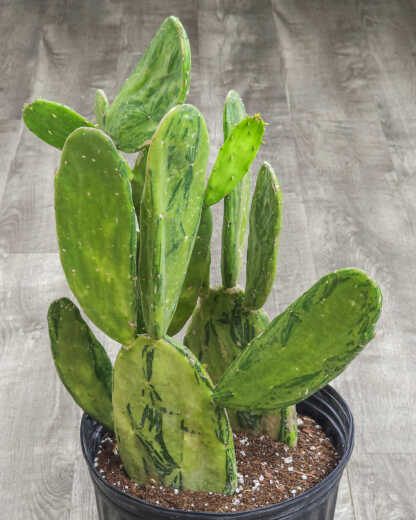
Variegated Prickly Pear Cactus
The Variegated Prickly Pear is a colorful cultivar of the Opuntia cactus family, prized for its stunning variegated foliage and ease of care, making it an excellent choice for indoor plant enthusiasts. Originating from the arid regions of the Americas, particularly the southwestern United States and Mexico, this unique succulent has gained popularity for its striking appearance and adaptability to indoor environments.
Characterized by its flat, oval-shaped pads adorned with a mesmerizing blend of green and creamy white stripes, the Variegated Prickly Pear adds a touch of elegance and visual interest to any indoor space. In addition to its eye-catching foliage, this cactus produces vibrant yellow flowers during the warmer months, further enhancing its ornamental appeal.
As a houseplant, the Variegated Prickly Pear thrives in bright, indirect light and requires minimal watering, making it well-suited for busy individuals or those new to plant care. Its ability to tolerate dry conditions and its low-maintenance nature make it an ideal choice for adding a touch of desert beauty to homes, offices, or indoor gardens. Whether admired for its aesthetic charm or appreciated for its easy care requirements, the Variegated Prickly Pear is sure to delight indoor plant enthusiasts of all levels.
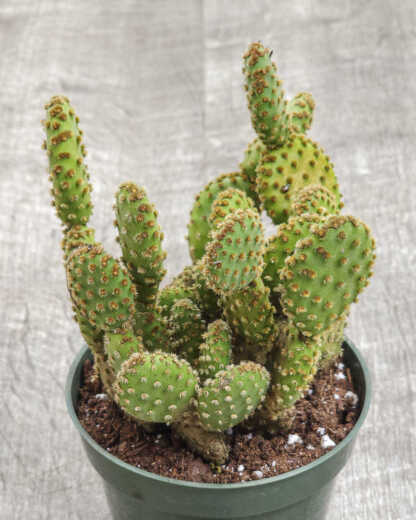
Yellow Bunny Ears Cactus
The Yellow Bunny Ear Cactus, scientifically known as Opuntia microdasys, is a delightful and charming succulent that has become a popular choice for indoor plant enthusiasts. Originating from the arid regions of Mexico, this cactus has earned its place as a beloved houseplant due to its unique appearance and ease of care.
Characterized by its flattened, oval-shaped pads adorned with numerous tiny golden spines resembling bunny ears, the Yellow Bunny Ear Cactus adds a touch of whimsy and personality to any indoor space. Its bright yellow spines contrast beautifully against its green pads, creating a striking visual display that captivates admirers.
As a houseplant, the Yellow Bunny Ear Cactus thrives in bright, indirect light and requires minimal watering, making it ideal for individuals with busy schedules or those new to plant care. Its compact size and low-maintenance nature also make it suitable for small living spaces or as a desk companion in offices.
Beyond its ornamental value, this cactus is also easy to propagate, allowing plant enthusiasts to share its beauty with friends and family. With its charming appearance and undemanding care requirements, the Yellow Bunny Ear Cactus is sure to bring joy and delight to any indoor environment.

White Bunny Ears Cactus
he White Bunny Ear Cactus, scientifically known as Opuntia microdasys 'Albata', is prized for its unique appearance and ease of care, making it an excellent addition to any indoor plant collection. Originating from the arid regions of Mexico, this cactus has gained popularity as a beloved houseplant due to its striking visual appeal and adaptability to indoor environments.
Characterized by its flattened, oval-shaped pads adorned with numerous tiny white spines resembling bunny ears, the White Bunny Ear Cactus adds a touch of elegance and charm to any indoor space. Its pristine white spines contrast beautifully against its green pads, creating a captivating display that brightens up any room.
As a houseplant, the White Bunny Ear Cactus thrives in bright, indirect light and requires minimal watering, making it ideal for individuals with busy schedules or those new to plant care. Its compact size and low-maintenance nature also make it suitable for small living spaces or as a decorative accent in offices and bedrooms.
Beyond its ornamental value, this cactus is relatively easy to propagate, allowing plant enthusiasts to share its beauty with friends and family. With its unique appearance and undemanding care requirements, the White Bunny Ear Cactus is sure to bring joy and elegance to any indoor environment.

Green Cathedral Cactus
The Green Cathedral Cactus, scientifically known as Selenicereus anthonyanus, is a unique cactus species prized for its intriguing appearance and suitability as a houseplant. Native to the rainforests of southern Mexico, this cactus stands out for its distinctive foliage and ease of care, making it an excellent choice for indoor plant enthusiasts.
Characterized by its elongated, flattened stems with deep lobes resembling the arches of a cathedral, the Green Cathedral Cactus exudes an air of elegance and mystique. Its deep green coloration and intricate pattern of ribs add to its allure, making it a captivating addition to any indoor space.
As a houseplant, the Green Cathedral Cactus thrives in bright, indirect light and requires minimal watering, making it suitable for individuals with varying levels of plant care experience. Its compact size and trailing growth habit also make it ideal for hanging baskets or as a decorative accent on shelves and windowsills.
Beyond its ornamental value, this cactus may produce stunning night-blooming flowers, adding a touch of exotic beauty to its surroundings. With its unique appearance and easy care requirements, the Green Cathedral Cactus is sure to impress and delight indoor plant enthusiasts seeking a distinctive and low-maintenance addition to their home or office.

Royal Red Cathedral Cactus
The Red Cathedral Cactus, scientifically known as Selenicereus anthonyanus 'Ruby Red', is an enchanting and distinctive cactus species prized for its striking appearance and suitability as a houseplant. Originating from the rainforests of southern Mexico, this cactus stands out for its captivating foliage and ease of care, making it an excellent choice for indoor plant enthusiasts.
Characterized by its elongated, flattened stems adorned with deep lobes resembling the arches of a cathedral, the Red Cathedral Cactus boasts a rich ruby-red hue that adds a dramatic and vibrant touch to any indoor space. Its intense coloration and intricate pattern of ribs make it a captivating focal point in any room.
As a houseplant, the Red Cathedral Cactus thrives in bright, indirect light and requires minimal watering, making it suitable for individuals with varying levels of plant care experience. Its compact size and trailing growth habit also make it ideal for hanging baskets or as a decorative accent on shelves and windowsills.
Beyond its ornamental value, this cactus may produce stunning night-blooming flowers, adding an extra layer of allure to its already captivating presence. With its unique appearance and easy care requirements, the Red Cathedral Cactus is sure to enchant and delight indoor plant enthusiasts seeking a striking and low-maintenance addition to their home or office.
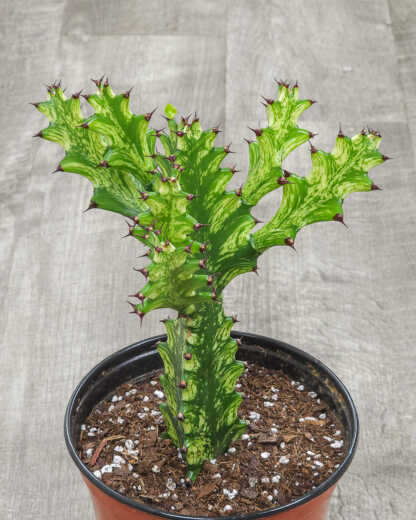
Mint Cream Cathedral Cactus
The Mint Cream Cathedral Cactus, scientifically known as Selenicereus anthonyanus 'Mint Cream', is a rare and unique cactus variety prized for its stunning appearance and suitability as a houseplant. Originating from the rainforests of southern Mexico, this cactus stands out for its enchanting foliage and ease of care, making it an excellent choice for indoor plant enthusiasts.
Characterized by its elongated, flattened stems with deep lobes resembling the arches of a cathedral, the Mint Cream Cathedral Cactus boasts a soft, pastel green hue with creamy white markings that add a touch of elegance and tranquility to any indoor space. Its delicate coloration and intricate pattern of ribs make it a captivating addition to any room.
As a houseplant, the Mint Cream Cathedral Cactus thrives in bright, indirect light and requires minimal watering, making it suitable for individuals with varying levels of plant care experience. Its compact size and trailing growth habit also make it ideal for hanging baskets or as a decorative accent on shelves and windowsills.
Beyond its ornamental value, this cactus may produce stunning night-blooming flowers, further enhancing its appeal. With its unique appearance and easy care requirements, the Mint Cream Cathedral Cactus is sure to enchant and delight indoor plant enthusiasts seeking a distinctive and low-maintenance addition to their home or office.
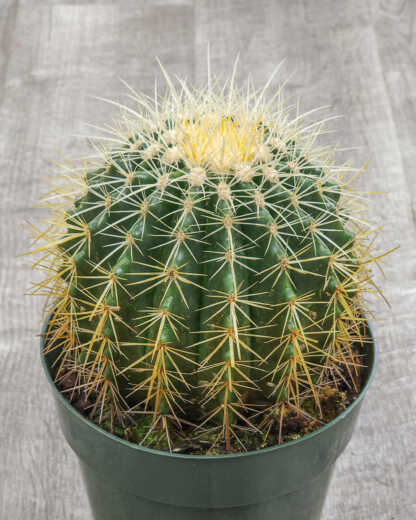
Golden Barrel Cactus
The Golden Barrel Cactus is a striking and iconic cactus species cherished for its distinctive appearance and suitability as a houseplant. Native to the arid regions of Mexico, particularly in the states of Hidalgo and Querétaro, this cactus has gained popularity worldwide for its captivating golden spines and globular shape, making it a sought-after addition to indoor plant collections.
Characterized by its spherical body covered in golden-yellow spines arranged in symmetrical rows, the Golden Barrel Cactus exudes a sense of regal elegance and desert charm. Its compact size and slow growth rate make it an ideal choice for indoor cultivation, adding a touch of warmth and sophistication to any living space.
As a houseplant, the Golden Barrel Cactus thrives in bright, indirect light and requires minimal watering, making it suitable for individuals with busy schedules or those new to plant care. Its drought-tolerant nature and low-maintenance requirements also make it an excellent choice for beginners looking to cultivate their green thumb.
Beyond its ornamental value, the Golden Barrel Cactus is a symbol of resilience and endurance, thriving in harsh desert conditions. With its striking appearance and easy care requirements, this cactus is sure to bring a touch of natural beauty and fascination to any indoor environment.
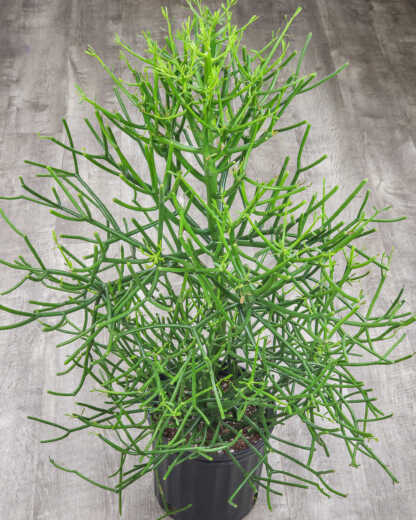
Pencil Cactus
The Green Pencil Cactus, scientifically known as Euphorbia tirucalli, is a unique and visually striking succulent prized for its slender, pencil-like stems and ease of care, making it an excellent choice for indoor plant enthusiasts. Originating from tropical and subtropical regions of Africa and India, this cactus has gained popularity as a beloved houseplant due to its intriguing appearance and adaptability to indoor environments.
Characterized by its upright, cylindrical stems that resemble pencils, the Green Pencil Cactus adds a touch of modern elegance and architectural interest to any indoor space. Its bright green stems feature small, inconspicuous leaves and can grow to impressive heights, making it a captivating focal point in any room.
As a houseplant, the Green Pencil Cactus thrives in bright, indirect light and requires minimal watering, making it ideal for individuals with busy lifestyles or those new to plant care. Its drought-tolerant nature and low-maintenance requirements also make it suitable for a variety of indoor environments, including offices, living rooms, or bedrooms.

Sticks of Fire Cactus
The Sticks of Fire Cactus, also known as Euphorbia tirucalli 'Sticks on Fire' or Firestick Plant, is a collector's favorite prized for its vibrant colors and unique form, making it an excellent choice for indoor plant enthusiasts. Originating from tropical and subtropical regions of Africa and India, this striking cactus has gained popularity as a beloved houseplant due to its eye-catching appearance and ease of care.
Characterized by its upright, pencil-thin stems that range in color from bright orange to fiery red, the Sticks of Fire Cactus adds a dramatic burst of color and texture to any indoor space. Its slender branches grow densely packed together, creating a mesmerizing visual display reminiscent of flames.
As a houseplant, the Sticks of Fire Cactus thrives in bright, indirect light and requires minimal watering, making it ideal for individuals with busy schedules or those new to plant care. Its drought-tolerant nature and low-maintenance requirements also make it suitable for a variety of indoor environments, including offices, living rooms, or sunny windowsills.
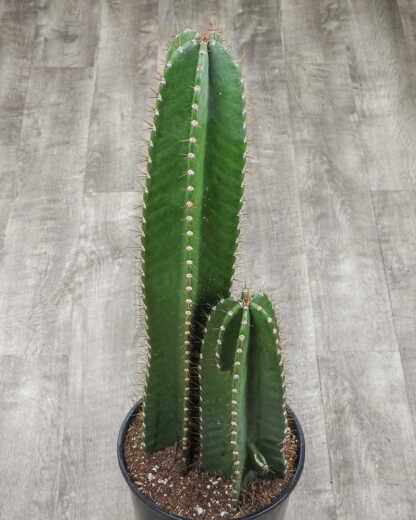
Peruvian Apple Cactus
The Peruvian Cactus, scientifically known as Cereus peruvianus, is a magnificent and versatile cactus species cherished for its striking appearance and adaptability, making it an exceptional choice for indoor plant enthusiasts. Originating from the arid regions of South America, particularly in Peru, this cactus has gained popularity worldwide for its impressive size, unique silhouette, and captivating nocturnal blooms.
Characterized by its columnar stems that can reach heights of up to 30 feet in its natural habitat, the Peruvian Cactus features ribbed, greenish-blue stems adorned with rows of small spines. Its architectural form and bold presence make it a standout addition to any indoor space, whether as a focal point in a living room or as a statement piece in a conservatory or greenhouse.
As a houseplant, the Peruvian Cactus thrives in bright, indirect light and requires minimal watering, making it suitable for individuals with varying levels of plant care experience. Its drought-tolerant nature and low-maintenance requirements also make it an excellent choice for indoor cultivation.
Beyond its ornamental value, the Peruvian Cactus produces magnificent white flowers that open at night, emitting a sweet fragrance to attract pollinators.

Brain Cactus
The Brain Cactus, scientifically known as Mammillaria elongata cristata or Mammillaria mammillaris, is a fascinating and distinctive succulent prized for its unique appearance and ease of care, making it an excellent choice for indoor plant enthusiasts. Originating from Mexico and parts of the southwestern United States, this cactus has gained popularity for its whimsical resemblance to a brain, adding a touch of curiosity and intrigue to any indoor space.
Characterized by its convoluted, knobby stems arranged in a clustered, brain-like pattern, the Brain Cactus showcases a captivating display of texture and form. Its greenish-blue stems are adorned with small, white spines, further enhancing its striking appearance and making it a standout addition to any indoor plant collection.
As a houseplant, the Brain Cactus thrives in bright, indirect light and requires minimal watering, making it ideal for individuals with busy schedules or those new to plant care. Its compact size and slow growth rate also make it suitable for small living spaces or as a decorative accent on desks, shelves, or windowsills.
Beyond its ornamental value, the Brain Cactus is relatively low-maintenance and can tolerate a range of indoor conditions, making it an excellent choice for beginners or anyone seeking an intriguing and easy-to-care-for houseplant.

Madagascar Palm
The Madagascar Palm, scientifically known as Pachypodium lamerei, is a uniquely exotic plant native to the island of Madagascar, off the coast of southeastern Africa. Despite its name, the Madagascar Palm is not a true palm but rather a member of the succulent family. Renowned for its striking appearance and adaptability, this plant has become a popular choice for indoor plant enthusiasts around the world.
Characterized by its thick, bottle-shaped trunk topped with clusters of long, narrow green leaves, the Madagascar Palm resembles a miniature palm tree, adding a touch of tropical elegance to any indoor space. As it matures, it may also produce small, star-shaped white flowers, further enhancing its ornamental appeal.

Old Lady Cactus
The Old Lady Cactus, scientifically known as Mammillaria hahniana, is a delightful and distinctive succulent that has become a beloved choice for indoor plant enthusiasts. Originating from the arid regions of Mexico, this cactus is cherished for its charming appearance and ease of care, making it an excellent addition to any indoor environment.
Characterized by its globe-shaped stems covered in soft white spines, resembling the tufts of hair often seen on elderly women, the Old Lady Cactus exudes a unique and endearing allure. Its compact size and slow growth rate make it suitable for small living spaces or as a decorative accent on desks, shelves, or windowsills.
As a houseplant, the Old Lady Cactus thrives in bright, indirect light and requires minimal watering, making it ideal for individuals with busy schedules or those new to plant care. Its ability to store water within its tissues allows it to withstand periods of neglect, making it a resilient and low-maintenance addition to any indoor space.

Ladyfinger Cactus
The Ladyfinger Cactus, scientifically known as Mammillaria elongata, is a captivating and resilient addition to any plant collection. Native to the rocky terrains of central Mexico, this charming cactus is celebrated for its distinctive cylindrical stems and delightful clusters.
The Ladyfinger Cactus forms dense, low-growing clusters of slender, finger-like stems that can reach up to 6 inches in length and about half an inch in diameter. Each stem is covered in rows of small, white or yellowish spines that create a soft, fuzzy appearance, making it both visually appealing and touch-friendly.


